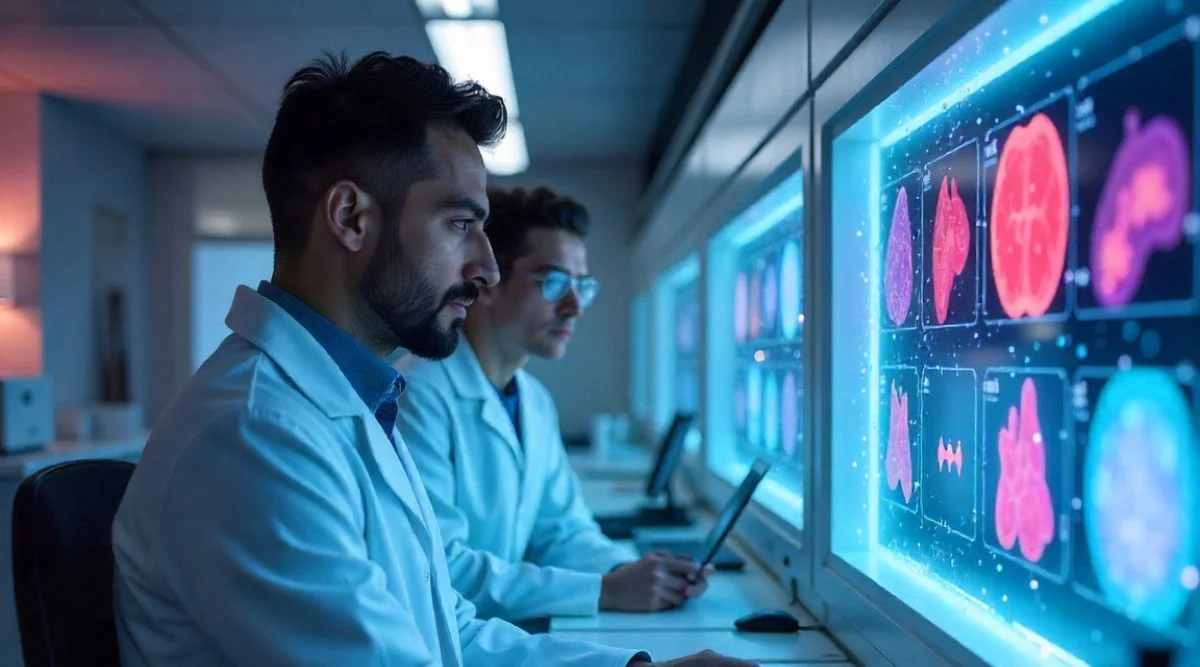Introduction
Artificial Intelligence (AI) is rapidly revolutionizing the field of pathology and clinical diagnostics. AI in Digital Pathology—the practice of converting biopsy slides into digital images for analysis—and other advances in AI in pathology are bringing unprecedented speed and accuracy to disease detection. This white paper explores how AI is being applied in both human and veterinary medicine, highlighting parallels and gaps between the two. It is authored by Rakesh Shukla, a computer-science entrepreneur who founded VOSD – India’s largest rescue and healthcare system for dogs – and who is known as “India’s Expert on Dogs.” VOSD operates the country’s largest referral hospital for stray dogs and even provides India’s first AI-based chatbot for canine care. With a deep technology background and having led India’s first AI conference for CXOs in 2017, the author offers a unique perspective at the intersection of advanced tech and animal health.
In the sections that follow, we examine the current landscape of AI in Digital Pathology globally and in India, along with complementary developments in AI in pathology workflows across human and veterinary domains. We review cutting-edge solutions—from human platforms like PathAI, Paige, and Ibex, to veterinary innovations by Idexx and Zoetis—and include visual data on performance and adoption. We also discuss the disparities in AI adoption between human and veterinary medicine, such as differences in data availability, infrastructure, and validation standards. Finally, we conclude with a look ahead at how initiatives like the upcoming AI4Dogs 2025 Summit aim to bridge these gaps and shape the future of AI in animal-health diagnostics.
AI in Human Digital Pathology: A New Era of Diagnostics
AI in Pathology is transforming human clinical diagnostics by improving the accuracy and efficiency of disease detection. AI in Digital Pathology is the underlying engine that makes these gains possible at slide-scanner scale. Across the world, pathology labs are adopting AI-powered systems to assist overburdened pathologists in analyzing tissue samples and lab results. This adoption is driven in part by a global shortage of pathologists and ever-increasing diagnostic workloads – for example, rising cancer caseloads without commensurate increases in pathology staff. AI offers a potential solution by acting as a “second set of eyes,” quickly screening digital slides for abnormalities so that specialists can focus on the most critical areas. However, implementing these systems requires digitizing slides (whole-slide imaging), which has historically been a bottleneck. Recent advances in scanner technology and regulatory approvals have begun to address this, enabling AI to enter routine practice and pushing AI in Digital Pathology from pilot to production.
Leading companies and technologies in human pathology have made significant strides:
Paige AI (USA): In 2021, Paige Prostate Detect became the first FDA-authorized AI in pathology application, a landmark in digital diagnostics. The Paige Prostate suite can automatically highlight suspicious tumor areas on digitized biopsy slides, assisting pathologists in detecting prostate cancer and even grading tumor severity with Gleason scores. By 2024, Paige had expanded its platform to detect multiple cancers and secured FDA Breakthrough Device designations for multi-tissue AI systems. These tools embody the promise of AI in Digital Pathology, reducing diagnostic delays by helping pathologists catch more cancers faster – for instance, Paige’s AI can flag high-risk prostate biopsies so they get priority review, potentially improving turnaround times in overstretched labs.
Ibex Medical Analytics (Israel): Ibex’s Galen AI platform is another frontrunner, with solutions for prostate, breast, and gastric cancer. In early 2025, Ibex achieved its first FDA 510(k) clearance for the Galen Prostate “Second Read” AI, which scans prostate biopsy slides for tiny malignant foci. Validation studies showed impressive performance – the AI’s heatmaps had a 99.6% positive predictive value, and it caught 13% of prostate cancer cases initially missed by human pathologists.
In a Lancet Digital Health study, the system achieved near-perfect accuracy (AUC 0.99) in identifying prostate cancers and high-grade tumors. Such results underscore how AI in Digital Pathology can enhance quality assurance, effectively acting as a safety net that alerts the pathologist to any cancerous areas that might have been overlooked.
Ibex has also obtained European CE-Mark approvals for its breast and prostate algorithms, and its use is expanding through partnerships (e.g., with Philips digital pathology and large lab networks). Notably, one of India’s top lab chains, Dr. Lal PathLabs, became the first in India to deploy Ibex’s AI platform in 2021 to improve cancer diagnosis quality and speed – an indication that emerging markets are also embracing these tools.
PathAI (USA): PathAI focuses on both clinical diagnostics and pharmaceutical research. It has developed AI models to quantify biomarkers and grade tumors on pathology slides with high precision. In mid-2025, PathAI’s AISight Dx digital pathology system received FDA clearance for primary diagnosis use in pathology workflows. This means U.S. labs can now use PathAI’s platform as the sole viewer for examining digital slides in lieu of a microscope, marking a regulatory milestone.
The clearance also included a novel FDA Predetermined Change Control Plan to allow rapid updates and integrations (e.g., adding new scanners) without repeated approvals. PathAI’s cloud-based system streamlines case management, enables remote collaboration, and integrates AI decision support into routine practice. These capabilities highlight how AI in pathology, delivered through robust cloud workflows, is not just about algorithms but also about end-to-end solutions that improve efficiency.
Others: Companies like Roche (venturing into AI-powered companion diagnostics for oncology), Philips (partnering with AI firms like Ibex to integrate AI in Digital Pathology into its Intellisite platform), Google Health (researching AI in pathology for screening), and startups such as Proscia and Lunit are all contributing to a vibrant ecosystem. The net effect is a trend toward augmented pathology, where pathologists leverage AI in Digital Pathology for more consistent, quantitative slide analysis and even for prognostic insights (e.g., predicting disease outcomes based on morphological patterns).
Despite these innovations, adoption in clinical settings is still in early stages. A 2024 survey of lab leaders in the U.S. found that only about 33% of labs have started or plan to implement digital pathology in their workflows. In other words, two-thirds of laboratories have yet to go digital, largely due to the cost of scanners and the disruption of changing entrenched workflows. The COVID-19 pandemic diverted capital and attention away from pathology digitization efforts, slowing progress.
Even among those who have gone digital, only ~31% expect AI and automation to significantly transform lab operations in the next 3–5 years. This cautious outlook reflects practical challenges: high initial investment costs, the need for IT infrastructure and data storage, and the imperative to train staff on new systems. Furthermore, some pathologists – especially from older generations – remain wary of relying on AI, preferring traditional microscopy for definitive diagnoses.
However, attitudes are gradually shifting as early adopters demonstrate the value of these tools. Laboratory leaders note that as success stories emerge (e.g., AI helping catch errors or expedite analyses), peer institutions become more willing to invest. In fact, the consensus is that AI in Digital Pathology becomes the “crown jewel” only after full slide digitisation – once that hurdle is cleared, pixel-level AI insights dramatically improve accuracy beyond human capability.
Another aspect to consider is the regulatory and validation environment. In human medicine, AI diagnostic tools are rigorously evaluated via clinical studies and regulatory pathways. The U.S. FDA and European regulators have begun granting clearances/approvals for AI in pathology solutions (as seen with Paige, Ibex, PathAI).
These validations require demonstrating that the AI performs at least as well as pathologists and improves diagnostic workflows without compromising safety. For example, the FDA clearance for Ibex’s prostate AI was supported by a study showing the system could detect cancers with extremely high accuracy and catch missed cases. Such evidence builds trust in AI tools among clinicians and administrators. We are now seeing AI-augmented pathology move from research to routine use in leading hospitals and labs, especially in North America and Europe.
The momentum is also financial: according to market analyses, the global digital pathology market (including AI in Digital Pathology systems) is valued around $1.4 billion in 2025 and projected to grow at ~13% CAGR, reaching $2.7 billion by 2030. Some broader definitions project even higher growth when including all hardware, software, and services – one report estimates a rise from about $9.1 billion in 2025 to over $31 billion by 2035, with AI in pathology integration as a key driver.
In summary, AI in human pathology is transitioning from promise to practice. Early adopters report faster turnaround times and improved diagnostic consistency, especially for tasks like cancer grading and identifying rare events in slides. Yet, widespread adoption will depend on cost-effective deployment and continued proof that these tools truly enhance patient outcomes. The trend is clearly moving toward closer human-AI collaboration in pathology: pathologists are still the final decision-makers, but AI in Digital Pathology increasingly handles the heavy lifting, scanning for needles in the haystack of data while AI in pathology systems deliver actionable insights at the point of care.
AI in Veterinary Pathology and Diagnostics
While human medicine has led the charge in digital pathology, AI in Digital Pathology for animals is now rapidly catching up through smart algorithms and automated scanners. Veterinary diagnostics are now rapidly catching up through AI. Veterinary pathology and laboratory testing traditionally faced similar challenges – manual microscopy for analyzing blood smears, urine sediments, cytology slides, and biopsies is labor-intensive and dependent on the skill of the technician or pathologist.
However, the veterinary field has additional hurdles: fewer board-certified veterinary pathologists are available per case volume (especially for the vast number of pets and farm animals), and many clinics lack on-site specialists, often having to send samples to distant labs. AI in pathology therefore offers a transformative opportunity to extend advanced diagnostic capabilities to the frontlines of veterinary practice, improving care for animals by enabling faster, in-clinic decision-making. In this section, we explore how companies are leveraging AI in Digital Pathology and other AI tools in veterinary lab diagnostics and pathology, and what unique challenges or advantages this domain presents.
Idexx Laboratories – a global leader in veterinary diagnostics – has been at the forefront of introducing automation and AI into everyday vet practice. Idexx supplies diagnostic analyzers to thousands of animal hospitals and has steadily augmented these devices with AI-driven software. A prime example is the IDEXX SediVue Dx Urine Sediment Analyzer, which was the first in-clinic veterinary device to use AI in pathology for microscopic analysis of samples.
Instead of a technician manually examining urine for crystals, cells, and bacteria, the SediVue uses an onboard camera and AI algorithms to do this automatically in under 3 minutes. It can identify the presence of bacteria (rods vs cocci), categorize cell types (RBCs, WBCs, epithelial cells), and detect crystals (struvite, calcium oxalate, etc.) with high precision. The system was trained on a massive library of over 350 million urine sediment images to recognise abnormalities. Each time clinics run samples, the AI continues to learn, further improving performance over time in a virtuous cycle. By automating this process, SediVue not only speeds up results but also reduces human error and variability – it provides consistent analyses regardless of the operator’s experience. Veterinarians benefit by being able to trust the machine’s output and focus more on explaining results to pet owners and formulating treatments, rather than peering into microscopes.
Another Idexx innovation is the ProCyte One Hematology Analyzer, which uses AI and advanced sensors for complete blood counts (CBC). This device can analyse blood cells in five dimensions (including light scatter and time-of-flight data) and uses algorithms to flag abnormal patterns. For example, it will automatically comment on results – if a dog’s CBC shows lymphopenia (low lymphocytes), the analyzer’s AI will flag it and suggest relevant interpretations. By doing so, these smart analyzers act as clinical decision-support tools, pointing vets toward potential diagnoses. Idexx’s approach underscores a broader trend: embedding AI in Digital Pathology concepts directly into bench-top lab instruments to augment what used to be manual tasks. As Idexx notes, this reduces the need for manual identification of cells, freeing up veterinary teams’ time and improving real-time patient care.
Zoetis, the world’s largest animal health company, has taken a slightly different but complementary route with its VETSCAN Imagyst platform. Rather than traditional bench-top analyzers, Imagyst is a digital microscopy and AI system that equips clinics with the ability to perform expert-level analyses on diverse sample types on-site. The Imagyst platform consists of a small scanner (Zoetis uses the Grundium Ocus® 40 portable whole-slide scanner) and a suite of AI algorithms in the cloud. Zoetis initially launched Imagyst for fecal parasite detection – a notoriously tedious test in vet clinics – and has since expanded it to multiple applications. As of 2025, Vetscan Imagyst offers seven distinct AI-driven tests in one device, making it the most comprehensive veterinary AI diagnostic analyzer available. These include:
- AI Fecal Analysis: The Imagyst AI examines fecal flotation slides to identify parasite eggs, cysts, and oocysts (e.g. roundworms, hookworms, giardia) with consistency that rivals expert parasitologists. Studies published in Parasites & Vectors and JVDI journals showed that the AI fecal results agreed closely with specialists’ findings. Importantly, the AI standardizes fecal exams by removing user variability – it doesn’t get tired or rush through an “unpleasant” task, meaning every sample gets a thorough review. Clinics benefit from faster parasite diagnoses and the ability to treat infections in the same visit, which can improve pet health and client satisfaction.
- AI Blood Smear Analysis: After a clinic runs an automated blood count, the Imagyst’s AI Blood Smear can perform a microscopic examination of a blood film. It verifies the white blood cell differential count, flags abnormal cells, and even identifies blood cell morphologic changes (like immature neutrophils, polychromatophils indicating regeneration, or abnormal RBC shapes). In essence, it provides a virtual pathology review of the smear, something that would normally require a clinical pathologist. This can catch issues like platelet clumps (which interfere with counts) or unusual cells that an automated CBC machine might not fully categorize.
- AI Dermatology Cytology: This module analyzes images of skin and ear cytology slides (impression smears, swabs) to detect bacteria and yeast, and even distinguishes bacterial morphology (rods vs cocci). Skin and ear infections are extremely common in pets. With AI, a vet can get a read on whether a skin sample has yeast overgrowth or bacteria within minutes, instead of either guessing or waiting a day for a lab report. The consistency is a big plus – the AI doesn’t miss yeast just because it’s scant or the field is full of debris, and it isn’t biased by a vet’s level of training. Zoetis validated this application with boarded dermatologists to ensure accuracy before release.
- AI Urine Sediment: Similar to Idexx’s SediVue, Zoetis has an AI to identify urine sediment elements. What’s clever is that the Imagyst scanner captures multiple focal layers of the slide (five layers for urine) to ensure nothing is missed. The AI then detects cells, crystals, casts, and bacteria in the urine. This was launched in 2024 to let vets do immediate urinalysis with confidence (previously many clinics had to send out urine for full analysis or rely on laborious manual exams).
- AI Masses (Cytology of Lumps): New in 2025, Zoetis launched AI Masses – an AI cytology analysis for fine-needle aspirates of common canine and feline masses like lymph node enlargements or skin tumors. This tool uses deep learning to detect cell patterns suggestive of neoplasia (cancer) versus inflammation or other conditions. In minutes, a vet can get an indication if a lump might be malignant, which traditionally would await a pathologist’s review. Zoetis announced that adding AI Masses makes Imagyst capable of screening a wide range of cytology cases at the point of care, potentially reducing the anxiety-filled wait time for pet owners when a suspicious lump is found. Of course, for confirmation, samples can still be sent to pathologists, but this AI triage is invaluable. Notably, Zoetis is showcasing this advancement at major veterinary conferences, underscoring how central AI is becoming in vet diagnostics.
Figure 2: AI-Powered Veterinary Diagnostics. Zoetis Vetscan Imagyst platform with its slide scanner and sample preparation kits. This point-of-care system allows veterinary clinics to perform AI-driven analyses of fecal, blood, cytology, and urine samples in-house, delivering results within minutes.
Beyond Idexx and Zoetis, other notable mentions include Mars Petcare (the pet healthcare giant that has research in AI diagnostics, especially in imaging) and startups like SignalPET (which applies AI to pet radiographs). In pathology specifically, startups have been fewer, but one crossover is Techcyte, a company whose AI algorithms for cytology/parasitology are actually licensed within some veterinary products (Zoetis’s fecal analysis is known to leverage Techcyte’s AI engine in the background). This highlights how collaboration between tech firms and veterinary companies is driving innovation.
An interesting case in India is SigTuple, a Bangalore-based startup bringing AI to laboratory microscopy. While their solution, SigTuple AI100, is targeted at human diagnostics, it exemplifies how emerging markets can leapfrog to AI-driven lab work. The AI100 is a two-part system: an automated digital microscope that scans slides, and AI software that analyzes blood smears, urine, and other samples. SigTuple’s platform can perform a full peripheral blood smear review in under a minute, doing >95% of what a human lab tech would do, leaving the pathologist to just verify and sign out results. It significantly boosts throughput (20-25 blood samples/hour vs a few manually) and improves access to expert analysis in remote labs. For instance, Krsnaa Diagnostics, which runs labs across India including rural areas, deployed AI100 systems so that local samples can be analyzed on-site and then reviewed centrally by pathologists via telepathology within minutes. The founder of SigTuple notes that less than 4% of labs worldwide have adopted digital microscopy with AI so far – illustrating the growth potential. SigTuple’s success (they’ve secured 21 patents and raised $44M) suggests that as the technology becomes affordable, even resource-limited settings can implement AI to improve accuracy, turnaround, and accessibility of diagnostics. While SigTuple’s current deployments are human-focused, one can foresee such platforms being adapted for high-volume veterinary labs in the future or for zoonotic disease surveillance.
It’s worth noting that veterinary medicine benefits from human medical advances, but also has unique considerations. AI algorithms often need retraining or adjustment to account for animal differences – e.g. cell morphology in dogs vs humans, or the range of normal findings across species (cats, horses, etc.). Companies like Zoetis validate their AI for each species (their current AI apps are validated for dogs and cats, and equine for fecal egg counts). Data availability can be trickier in animals; however, corporations have been building proprietary datasets (Idexx’s 350M image library for urine, Zoetis using 5-year image archives for Imagyst). Another difference is regulatory oversight: human diagnostics require regulatory approval (FDA, CE) while veterinary diagnostics have a somewhat lower regulatory barrier (often considered just lab equipment, with companies self-validating). This can allow faster innovation in vet AI, but it also means the onus is on companies to ensure quality via rigorous field trials and publishing results. So far, the major players have indeed conducted validation studies and even published peer-reviewed papers on their AI’s performance, which is building confidence in the veterinary community.
Adoption of AI in veterinary settings is starting to accelerate, especially in North America and Europe. Thousands of vet clinics worldwide use Idexx’s in-house analyzers (which are increasingly AI-enabled), and Zoetis reported a growing install base of Imagyst since its launch in 2020. The value proposition in vet medicine is strong: AI can democratize access to specialist-level diagnostics. For example, a general practice veterinarian in a small town can, with a digital cytology scanner, get a board-certified pathologist’s report on a tricky case within 2 hours through systems like IDEXX Digital Cytology. Or they can get an instant AI screening on that case to guide immediate care. This was unheard of a few years ago.
However, challenges remain. Cost is a barrier for smaller clinics – though devices like Imagyst or digital cytology scanners eventually pay off in efficiency, the upfront investment and per-use fees must be justified by case volume. There’s also a mindset shift: veterinarians (especially older ones) who are used to manual microscopes may need convincing to trust AI findings. Echoing human medicine, younger veterinarians are generally more receptive to digital tools. Over time, as they become practice owners and decision-makers, digital pathology and AI are likely to be standard offerings. Already, large veterinary hospital networks and reference laboratories are adopting these technologies to improve service quality. For instance, Neuberg Diagnostics in India (a major lab chain) integrated digital pathology and AI to replace older vet pathology methods in its labs, though their chairman noted that adoption of AI in anatomic pathology has not been as fast as hoped, partly due to pathologist hesitation and the emerging nature of the tech. That is changing as successes are documented and as the One Health perspective gains traction – the understanding that advancements in human health (like AI diagnostics) can translate to animal health and vice versa, to the benefit of both.
Below is a summary of representative AI-driven solutions in pathology and diagnostics, comparing some human vs. veterinary applications:
| Solution / Company | Human or Vet? | Focus Area & AI Capability | Notable Achievements |
| Paige Prostate (Paige AI) | Human (Pathology) | AI for prostate biopsy analysis – detects cancer, grades tumors (Gleason). | First FDA-cleared AI in pathology (2019/2021); landmark in clinical AI adoption. |
| Galen Platform (Ibex) | Human (Pathology) | AI for multi-tissue cancer diagnosis (prostate, breast, etc.) – highlights malignancies on slides. | Detected 13% of cancers missed by experts; FDA-cleared for prostate cancer (2025). |
| AISight Dx (PathAI) | Human (Pathology) | Digital pathology workflow with AI decision support and image management. | FDA-cleared for primary diagnosis (2025); integrates AI into routine pathology practice. |
| IDEXX SediVue Dx | Veterinary (Lab) | AI-powered urine sediment analyzer – identifies cells, crystals, bacteria in urine in ~3 minutes. | First in-clinic AI microscope for vets; trained on 350M+ images to continually improve accuracy. |
| Zoetis Vetscan Imagyst | Veterinary (Multi-use) | AI platform with multiple applications – fecal parasite ID, blood smear differentials, cytology (derm, masses), urine. | Offers 7 AI tests in one device (world’s most comprehensive vet AI diagnostic); in-clinic results in minutes rivaling expert labs. |
| SigTuple AI100 (India) | Human (Lab) | Automated digital microscope + AI for blood and urine – pre-classifies WBCs/RBCs/platelets on smears. | <4% of labs globally have such tech; deployed in Indian labs to enable tele-pathology and faster reporting across geographies. |
| IDEXX Digital Cytology | Veterinary (Telepathology) | Whole-slide scanner + network of pathologists – AI assists scanning, then specialists review 24/7. | Delivers cytology results with images within 2 hours; improves access to board-certified pathology expertise worldwide. |
Table 1: Select AI-Driven Diagnostic Solutions in Human vs. Veterinary Medicine. (Sources: Company publications and news)
Bridging the Gap: Adoption Challenges and Opportunities
Despite the impressive technologies highlighted above, there remains a significant gap in AI adoption between human and veterinary medicine. Several factors contribute to this disparity:
- Data and Algorithm Development: High-quality, annotated data is the fuel for AI. Human pathology benefits from large datasets – thousands of digitized slides of common cancers, often with established ground truth diagnoses. In contrast, veterinary data is fragmented. For example, there is no centralized repository of dog or cat biopsy images at the scale of human cancer databases. Animal diseases also encompass multiple species; an AI trained to detect tumors in dogs might not immediately generalize to horses or cats without additional training. Veterinary companies have started to build their own datasets (Zoetis collected years of images for parasites, Idexx for urine, etc.), but these are proprietary and smaller in scale than human medical datasets. Moreover, variability in animal breeds and anatomy can pose challenges – what’s normal for one dog breed might be abnormal for another. The opportunity here is for collaboration and data-sharing in the vet community, perhaps via research consortia, to pool images and cases for AI development. One promising sign is that academic veterinary schools are increasingly exploring AI research, sometimes in partnership with human medical institutions, under the One Health initiative.
- Infrastructure and Cost: Adopting digital pathology requires investment in scanners, computing, and storage. As noted, even human labs have been slow due to cost. Veterinary clinics often run on tighter budgets and lower test volumes, making it harder to justify these purchases. A $100,000 whole-slide scanner for a small animal hospital is not practical. The vet industry has cleverly tackled this by creating cheaper, fit-for-purpose devices (e.g. the Imagyst scanner is compact and likely more affordable than a clinical hospital scanner) and by using cloud-based analysis (the heavy AI computation happens on Zoetis or Idexx servers, not on the clinic’s computer). This lowers the on-site hardware requirements. Subscription models also help – a clinic can pay per use or a monthly fee rather than a huge upfront sum. Still, for many vet practices, especially in developing countries, basic needs take priority over high-tech additions. This is why adoption is currently concentrated in referral hospitals, corporate clinic chains, and urban practices that have the case load and revenue to support it. Over time, as costs come down (as they typically do with tech scale-up) and as these tools prove their worth in saving time and improving care, broader adoption should follow. Notably, in India, large lab chains like Dr. Lal PathLabs deploying digital AI diagnostics in vet pathology and startups like SigTuple focusing on affordability indicate that cost barriers can be overcome with innovation and volume.
- Validation and Trust: In human medicine, a clear regulatory framework (FDA, EMA approvals) ensures that AI tools undergo rigorous validation. The veterinary side does not always require equivalent regulatory approval, which can be a double-edged sword. On one hand, it allows faster rollout of new AI tools; on the other, it may leave some vets skeptical without an external stamp of approval. To build trust, companies have been proactive in conducting studies and publishing data. For instance, Zoetis validated each AI application with board-certified specialists and often cites peer-reviewed studies or “data on file” from trials in hundreds or thousands of samples before commercialization. Idexx, similarly, leveraged its huge image databases to ensure their analyzers’ AI results match up with expert interpretations. Educating practitioners is crucial – veterinarians need to know what an AI result means, its limitations (e.g. “unable to categorize rare cell type”), and how to integrate that into their clinical decision. Over time, as vets see AI concur with and augment pathology results, confidence will grow. It’s analogous to how human radiologists initially were cautious about AI, but as studies showed AI could reliably flag lung nodules or fractures, it became seen as a helpful assistant.
- Workflow Integration: Introducing AI diagnostics into a workflow requires changes in how samples are processed and results utilized. For example, a vet clinic adding digital cytology must train technicians to prepare and scan slides properly, and to interact with the software. There can be a learning curve, and busy clinics might resist any process that initially slows them down. The Labcorp survey for human labs noted that leaders are hesitant to change well-established workflows without clear ROI, and the same applies in vet clinics. The upside is once integrated, these tools often streamline workflows – e.g. faster results mean a pet can start treatment sooner and avoid a second visit. Early adopter vets often become evangelists when they realize they can, say, diagnose a dog’s lymphoma on the same day via AI cytology and refer to oncology immediately, rather than sending slides out and waiting 2-3 days. Showcasing these real-world benefits will be key to persuading more clinics to adapt.
- Human Expertise vs. AI: In veterinary pathology, as in human, the role of AI is assistive, not replacement. Veterinary professionals – pathologists, clinicians, lab technologists – are still critical for oversight and for handling complex, ambiguous cases. AI might flag “potential mast cell tumor” on a cytology image, but the pathologist will make the definitive call and perhaps perform additional tests. Emphasizing this collaborative aspect can alleviate fears that AI is meant to cut jobs or remove the human element. It’s more about extending the reach of scarce experts. For instance, one veterinary pathologist can, through telepathology and AI triage, supervise far more cases across the country than they could solely on physical slides, thereby addressing specialist shortages in underserved regions.
Looking at adoption rates quantitatively, precise numbers in vet med are hard to come by, but we can gauge trends. As of 2025, only a few thousand veterinary clinics (out of tens of thousands globally) likely have advanced AI diagnostic tools in-house – meaning there is vast room for growth. On the other hand, nearly all major veterinary diagnostic reference labs (the large centralized labs) are experimenting with or already using AI in some form, whether internally or through partnerships. This top-down dissemination (from reference labs and corporate networks to individual practices) will likely accelerate. The table below summarizes the adoption contrast:
- In human medicine: Approximately one-third of labs are in the process of going digital (hence able to use AI). Many AI tools are still in pilot phases, with a handful of approvals that are mostly in specialized centers.
- In veterinary medicine: Only an estimated 5-10% of well-equipped clinics have adopted AI-enhanced diagnostics to date (if we count all Idexx AI analyzer users and Zoetis Imagyst users). However, many more benefit indirectly when they send samples to reference labs that use AI (for example, a local vet sending biopsies to a lab that uses Ibex’s AI or digital cytology means the pet’s diagnosis is effectively AI-assisted even if the clinic itself doesn’t have the technology).
Despite the differences, the trajectory is clearly converging – both fields are moving toward widespread adoption of AI, simply on slightly different timelines and scales. The gaps identified are being actively addressed by stakeholders: governments and industry are investing in AI research, training programs are teaching new veterinarians and pathologists about digital tools, and collaborative forums are being established to share knowledge across the human-vet divide.
Future Outlook and the AI4Dogs 2025 Summit
AI’s integration into pathology and lab diagnostics is still in its early chapters. In the coming years, we can expect more sophisticated algorithms – possibly multi-modal AIs that combine image analysis with genomic data or clinical records to provide holistic diagnostic insights. In both human and veterinary medicine, AI could evolve from identifying diseases to also prognosticating outcomes and suggesting treatment paths (for instance, predicting which tumors are likely to respond to a certain therapy). The concept of “Digital Twin” patients, where AI models simulate how a disease might progress, could extend to animals as well, aiding in personalized veterinary care.
For the veterinary field specifically, the future holds immense promise. Imagine AI models that can diagnose exotic pet illnesses (parrot pathology anyone?) or automatically survey livestock for early signs of an outbreak via smart imaging devices in the field. Drones with imaging AI might one day monitor herd health from above, and AI-driven mobile labs could bring diagnostic capabilities to remote farms or wildlife conservation areas. Such developments align with the broader One Health framework, where monitoring and maintaining animal health is directly linked to human public health (as seen with zoonotic diseases). AI in pathology will be a force multiplier in One Health efforts, detecting patterns and anomalies across human and animal data that would be impossible to see otherwise.
However, reaching that future requires collaboration and knowledge exchange. This is where platforms like the AI4Dogs 2025 Summit come in. VOSD (Voice of Stray Dogs), leveraging its unique position at the crossroad of animal welfare and technology, is hosting the 1st International AI + Veterinary Science Summit – dubbed AI4Dogs 2025 – in September 2025. This summit in Bengaluru, India, will be one of the first global forums to explicitly bring together veterinarians, medical researchers, AI experts, industry leaders, and policy-makers under one roof. The goal: to accelerate the adoption of AI in animal health and ensure that its benefits are accessible worldwide.
At AI4Dogs 2025, participants will share success stories and research findings, but also confront the challenges we discussed. How do we gather more training data for veterinary AI? How can we validate algorithms for safety and effectiveness in animals? What business models work to make AI affordable for a solo veterinary practitioner in a small town? Through workshops and panels, the summit aims to create a roadmap for the next decade of innovation. It’s also a platform for cross-pollination between human and veterinary domains – for example, a session might explore how an AI that detects tuberculosis in human sputum could be adapted to detect bovine TB, or how veterinary pathology workflows might actually inform new approaches in human labs (veterinary labs often have to be more flexible given they handle all species; this agility could inspire human systems).
The choice of focus on “Dogs” in AI4Dogs is symbolic as well. Dogs are humanity’s closest animal companions and often mirror human health issues (they get cancers, diabetes, etc., and even play roles in clinical trials for new therapies). By improving AI diagnostics for dogs, we improve their healthcare and well-being – which is the core mission of VOSD – but we also push the frontier of AI in pathology in ways that can translate to other animals and back to humans. In that sense, the summit embodies the spirit of One Medicine: breaking down silos between species and disciplines for the common advancement of health.
It is particularly fitting that Rakesh Shukla – as an entrepreneur who has straddled the tech world (through ventures like TWB and organizing pioneering AI conferences) and the animal care world (through VOSD) – is spearheading this effort. His journey reflects the convergence we are now witnessing: deep tech expertise being applied to solve age-old problems in veterinary care. Back in 2017, at the TWB AutomationShift conference, he highlighted how AI-driven automation would reshape industries and urged leaders to embrace this change. Today, that vision is materializing in the veterinary field – perhaps an unexpected industry to some, but one profoundly ripe for innovation.
In conclusion, the use of AI in digital pathology and laboratory diagnostics is a transformative development poised to benefit both humans and animals. It offers faster diagnoses, greater accuracy, and the ability to extend high-level diagnostic services to wherever they are needed – be it a rural human clinic or an animal shelter’s hospital. The veterinary sector, sometimes considered a step behind human healthcare, is rapidly leveraging AI to leap ahead in areas like point-of-care testing and telemedicine for pets. As we have seen, companies are actively bridging the gap with tailored solutions, and early outcomes are very promising. The remaining challenges are not trivial, but they are surmountable with collaborative effort and continued technological progress.
The next few years will likely see convergence: human pathology AI will get better at generalizing and perhaps start addressing cross-species problems (like zoonotic disease detection), while veterinary AI will gain from larger datasets and techniques proven in human medicine. Events like AI4Dogs 2025 serve as important milestones in this journey – rallying the community to share, learn, and commit to a future where AI is an indispensable ally in diagnostics. The ultimate winners of this trend are the patients: the people and the animals whose diseases can be caught earlier, diagnosed more accurately, and treated in a more timely fashion. Whether it’s a pathologist pinpointing a tiny carcinoma on a slide or a veterinarian detecting a parasite in a rescued street dog, AI is empowering experts to do more and do better. In the words of Matt Sause, CEO of Roche Diagnostics, upon a recent AI milestone, innovation in diagnostics enables more precise care – and that is the north star guiding AI adoption in both human and veterinary domains.
As we look beyond 2025, one can envision a world where no biopsy goes unanalyzed due to lack of a specialist, no outbreak festers undetected in an animal population, and no pet’s illness is left mysterious for weeks. AI will not solve all problems, but in diagnostics it will significantly tilt the odds in favor of faster answers and better outcomes. The ongoing collaboration between industries, and summits like AI4Dogs, ensure that we move forward together, sharing breakthroughs from Bangalore to Boston to benefit all creatures great and small. The era of AI in pathology and lab medicine is here – now it’s up to us, as technologists, doctors, veterinarians, and entrepreneurs, to harness its full potential for the good of patients everywhere.








